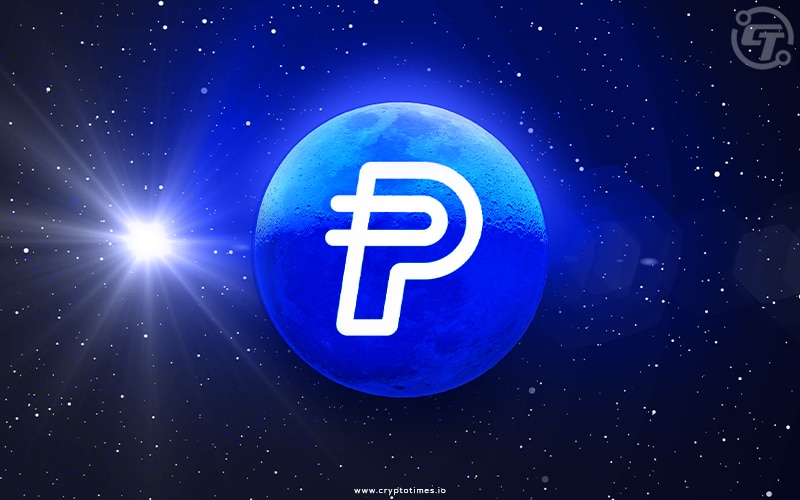Have you ever experienced inconvenience or faced issues while sending money to someone located in another country? Back in the day, numerous platforms emerged to provide a solution to this exact problem. Among the many names, PayPal is the one that has strived over decades and has now turned into a popular platform for cross-border transactions.
Now there is some slippage and PayPal does process payments with some surcharges on the transaction, to make things more simple the management announced it’s own stablecoin that will be based on the USD. The PayPal stablecoin project is something that seems to have the potential to resolve this issue.
A few days ago, PayPal introduced its own stablecoin, “PYUSD”, on the Ethereum blockchain network, becoming the first online payments service to do so. However, many people mistake PYUSD for other cryptocurrencies like BTC or ETH, even if it is not. In this article, we have explained what the PayPal stablecoin PYUSD is and how it will change the global payment system, as well as the bursting myths around this project.
What is PayPal Stablecoin, or PYUSD?
PayPal USD or PYUSD is the stablecoin launched by the leading global payment giant PayPal backed by USD. It is developed with an ERC-20 token standard on the Ethereum blockchain.
Here note that Paxos Trust Company issues PYUSD. As PYUSD rolls out, you can buy, sell, hold, and transfer it in the PayPal app or on their site. PYUSD is mainly developed to make digital payments. It is 100% pegged to US dollar deposits, short-term Treasuries, and similar cash equivalents.
Why is PayPal Launching a Stablecoin?
PayPal is launching stablecoin to establish leadership in the cryptocurrency space and offer innovation to its vast user base of over 430 million monthly users. This stablecoin, PYUSD, simplifies fund transfers like remittances and aligns with the emerging Web3 internet era, where transactions are more user-controlled and secure.
By being Web3-compatible, PayPal positions itself at the forefront of future digital payments. They’re working with regulated partner Paxos to manage the stablecoin, ensuring transparency and trust. Through this move, PayPal seeks to stay ahead in crypto, improve transaction ease, and play a pivotal role in the evolving online landscape.
How Does PYUSD Work?
PYUSD’s primary purpose is to offer users an alternative to cryptocurrencies that experience significant price fluctuations. Unlike Bitcoin or Ethereum, which can have substantial value changes in short periods, PYUSD’s value remains relatively constant because it is pegged to the U.S. dollar. This pegging means that 1 PYUSD is intended to have the same value as 1 U.S. dollar.
To ensure stability, PayPal backs each unit of PYUSD with real-world assets. These assets include USD deposits, short-term U.S. treasuries, and similar cash equivalents. This backing ensures that the value of PYUSD stays in line with the U.S. dollar even if the broader cryptocurrency market experiences fluctuations.
PYUSD can be acquired by eligible PayPal customers in the United States through PayPal’s app or website. Users can then use PYUSD for online purchases at stores that support PayPal transactions. Additionally, it can be transferred to cryptocurrency wallets that support PYUSD, such as Coinbase Wallet and MetaMask. U.S. PayPal clients can even use PYUSD to buy other cryptocurrencies like Bitcoin, Bitcoin Cash, Ether, and Litecoin.
The stability and compatibility of PYUSD make it well-suited for Web3 environments, which are considered the next generation of the internet. In these settings, users have more control over their data and interactions. Cryptocurrencies like PYUSD can facilitate direct, secure, and peer-to-peer transactions without intermediaries, like banks, enhancing efficiency and reducing costs.
Also Read: CBDC vs. UPI: Decoding the Differences in Digital Payment Systems
Benefits of PYUSD For Users and Crypto Ecosystem
Here are some significant benefits that PYUSD can offer to enhance PayPal’s financial landscape.
1. Cheaper and Faster Transactions
The first and foremost benefit that PYUSD offers is that it will boost transaction speed thanks to the integration of blockchain technology. Furthermore, one can use this PYUSD for different purposes around the globe, including remittances.
2. Boost Web 3 Economy
As the Web 3 ecosystem continues to evolve at an unprecedented pace, the integration of PYUSD introduces a vital layer of accessibility, enabling participants from various sectors to seamlessly engage, transact, and contribute to the flourishing digital economy.
3. Universal Currency
In the modern multi-polar world, various fiat currencies like USD and Yuan are fighting to win the throne of universal currency. Stablecoin could become a part of such cut-throat competition due to technological advancement and the transparency it carries. Stablecoin from PayPal will allow people around the world to make cross-border transactions.
PYUSD’s Impact on the Cryptocurrency Landscape
If the PYUSD gains wider adoption through PayPal’s popularity, it may have some impacts on the cryptocurrency landscape.
1. Wider Adoption
PayPal has a significant user base, so their stablecoin could lead to wider adoption of cryptocurrencies and blockchain technology. This might attract new users who are already familiar with PayPal’s platform.
2. Stability and Usability
Stablecoins are designed to be less volatile than many other cryptocurrencies, making them more suitable for everyday transactions. As PYUSD is stable and easily usable for purchases and transfers, it could increase the practicality of using cryptocurrencies in daily life.
3. Competition with Other Stablecoins
If PayPal’s stablecoin gains traction, it could compete with other popular stablecoins like USDC, USDT, and DAI. This might lead to improvements and innovations in the stablecoin space as different projects strive to offer better features.
4. Regulatory Scrutiny
The launch of a stablecoin by a company like PayPal could attract regulatory attention. Regulators might scrutinize the coin’s compliance with existing financial regulations, potentially shaping the way stablecoins are treated legally.
5. Financial System Integration
Depending on how PayPal integrates PYUSD into its platform, it could create a more seamless connection between traditional financial systems and the cryptocurrency world. This could potentially bridge the gap between the two and make it easier for mainstream users to enter the cryptocurrency market.
Also Read: 9 Real-World Use Cases of Blockchain Technology in 2023
Conclusion:
PayPal’s foray into the crypto space with its own stablecoin, PYUSD, draws the attention of a lot of newbies. Also, PYUSD unlocks the real-world use cases of stablecoin for the sake of enhancing the digital payment system. However, PYUSD might face some regulatory challenges before it gains mainstream adoption in some countries where the crypto critic regime is present. Although virtual currency is the future, it’s better for governments and regulatory authorities to accept this fact as early as possible.







